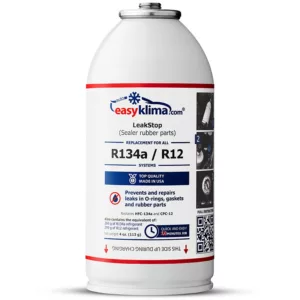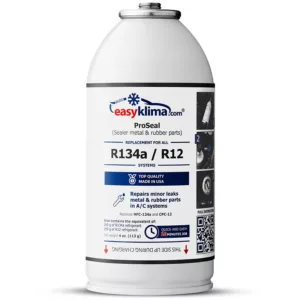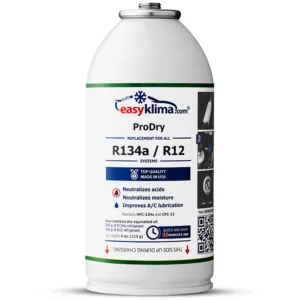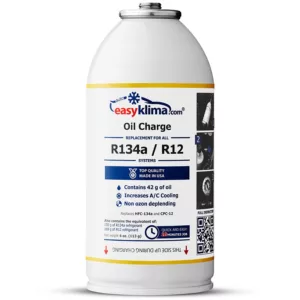Self-filling car air conditioning – what you should know?

In summer, especially during hot weather, an efficient air conditioning system in the car is an invaluable asset that has a direct impact on the comfort of the journey. There is nothing worse than driving in a stuffy, hot space. That’s why filling up your car’s air conditioning is an integral part of ensuring your comfort and enjoyment when travelling.
Filling your car air conditioning is a simple process that you can successfully do yourself, saving you time and money. Beforehand, however, it’s helpful to understand how your car’s air conditioning works and why it needs to be filled. We’ll also give you tips on what you’ll need for the process. You will also find out when is the best time to fill up the air conditioning in your car, how much it costs and what other repairs you can do yourself.
In this article you will learn, among other things:
- how the air conditioning in your car works and why it needs to be topped up,
- when you should fill up the air conditioning,
- whether it is worth having your air conditioning serviced,
- how much does it cost to have your car’s air conditioning serviced?
- how to service your car air conditioning yourself,
- what products and tools are needed to refill the air conditioner,
How does the air conditioning work in a car? Why should it be topped up?
The air conditioning in a car is an extremely important system to maintain a comfortable temperature and humidity inside the vehicle. This makes travelling on hot days more pleasant and relaxing. How exactly does this system work?
The process of air conditioning in a car is based on a refrigeration cycle that involves four main components: the compressor, condenser, evaporator and expansion valve. Each of these components plays an important role in the temperature control process.
The operation of air conditioning begins at the compressor. Its job is to compress the refrigerant, i.e. the gas used in automotive air conditioning, most commonly R134a, R12 or R1234yf. The compressed gas raises the pressure and temperature of the refrigerant, preparing it for the next stage of the cycle. The compressed refrigerant then leaves the compressor and passes to the condenser, which is usually located at the front of the car, behind the radiator. The condenser removes heat from the gaseous refrigerant to the environment, while condensing it to liquid form. The liquid refrigerant passes through an expansion valve, which controls the flow of refrigerant into the evaporator. This valve depressurises the refrigerant, causing it to evaporate and cool further. The evaporated refrigerant passes into the evaporator. Here the refrigerant evaporates, taking heat from the air and lowering the temperature inside the cabin. A fan blows the air, which passes through the evaporator, where it is cooled and then directed into the car’s interior through the air vents. This ensures that the temperature inside the vehicle is lowered.
The key element responsible for the operation of air conditioning is the refrigerant. Unfortunately, for various reasons, the amount of this gas can decrease over time. This can be caused by leaks in the system, natural consumption of the refrigerant or minor damage. When this happens, the refrigerant must be topped up to restore full air conditioning performance.
Filling the air conditioning in the car – When should it be done?
First of all, it is important to understand that the loss of refrigerant in car air conditioning is a normal occurrence. A small amount of wear and tear is a natural occurrence associated with the use of the air conditioning system and can vary in frequency. Losing more refrigerant can indicate a problem, such as a leak in the system. Therefore, it is important to check the refrigerant level regularly and refill the car air conditioner if necessary.
The frequency of A/C refilling can vary depending on several elements. The first is the age of the car – older vehicles often have larger leaks and may require more frequent car air conditioning refuelling.
Another factor is how and how intensely you use your car. If you frequently travel in high temperatures or use your air conditioning for long periods of time, you are more likely to need to have your car’s air conditioning serviced more frequently. It is worth noting that regular use of the air conditioning can help to maintain its efficiency and prevent major leaks.
To determine when you need to top up the refrigerant in your car’s air conditioning, it is recommended that you regularly check the refrigerant level using a line with a pressure gauge. When connected to the low pressure valve, you will get a pressure reading on the manometer. A green colour means that the pressure is correct and the system does not need to be filled with A/C.
Is it worth getting your air conditioning serviced?
Having your car’s air conditioner serviced does not have to be a chore. Filling up the A/C or repairing minor leaks are easy tasks that you can do yourself.
First of all, the cost of A/C service can be high. Service centres often charge for labour, materials and possible additional services, which can put a significant strain on your wallet.
Secondly, filling the air conditioning in your car yourself gives you time flexibility. You don’t have to make an appointment at the service centre, wait in line for an appointment or adjust to opening hours. You can take care of the air conditioning yourself when it suits you, which is certainly a big plus for people with busy schedules.
Another consideration is the comfort and time required for the entire process. You can charge the A/C refrigerant yourself in about 10 minutes. If you opt for a service, you have to reckon with spending several hours in traffic, especially in larger cities. You also have to add the time you will spend in the service station waiting for the service, and the time the service technicians perform the service itself. You can save these hours by fitting the air conditioning yourself.
Filling up your car’s A/C does not have to be done at a service centre, as you can do it yourself. There are various benefits associated with filling the air conditioning yourself, such as lower costs, greater flexibility and time savings. You can avoid high service charges and do not have to adjust to service opening hours. Filling the air conditioner yourself gives you full control over the entire process and saves you money and time.
How much does it cost to get air conditioning serviced in a car?
The price of having your car’s air conditioning serviced can vary depending on a number of factors. First and foremost, the way in which you choose to have this procedure carried out is important. If you go to an authorised car service, you can expect higher costs, especially in larger cities.
If you opt for a less reputable service, the price of an A/C refill can be lower, but this usually also entails a lower quality of the refrigerant used. A/C filling may be unstable or ineffective, which will lead to additional costs or the need to repeat the A/C filling process at short intervals.
If you are concerned not only with a low price, but also with the quality of the refrigerant, the best solution is to refill the air conditioner yourself. In this case, you only need to spend money on buying a suitable car air conditioning refill kit. The prices of such kits vary depending on the type of refrigerant.
How do I fill up my car’s air conditioning by myself?
To top up your air conditioning yourself, all you need is an air conditioning filling gas and a hose with a pressure gauge. Each of these products comes with a diagnostic diagram and step-by-step instructions that guide you through the process. Alternatively, you can choose a ready-made air conditioning refill kit, which contains everything you need. Kits may vary depending on the car and the type of refrigerant used in the air conditioning.
Once you have received your package, all you need to do is follow a few simple steps to enjoy a working air conditioner:
Po otrzymaniu przesyłki wystarczy wykonać kilka prostych kroków, aby cieszyć się sprawną klimatyzacją:
- Shake the preparation can and connect it to the charging hose. Then turn on the car engine and the air conditioning in internal circuit mode with maximum power and lowest temperature.
- Connect the hose with the pressure gauge to the low pressure valve, positioning the can with the valve down. For some models and vintages, connect the line to the high pressure valve, using the HP to LP Adapter.
- Start measuring the pressure of the system (see detailed description for pressure gauge):
- white colour – system pressure too low (below: 25 psi),
- green colour – correct A/C system pressure (between 25 and 55 psi),
- red colour – indicates too high system pressure (above: 55 psi).
- Open the needle valve in the line with the pressure gauge and start charging.
- Finish charging when the pressure gauge reads between 25 and 55 psi (range indicated in green on the pressure gauge).
- Leave the car for a further 20 minutes in the mode described in step 1.
- 2 weeks after the steps described in point 1, it is recommended to measure the pressure again as described in point 3.
How long does it take to have the air conditioning in my car serviced? The whole process should not take more than 10 minutes. If you want to get rid of minor leaks before refilling the A/C, you should first apply LeakStop sealant.
What products and tools do I need to top up my air conditioning?
Filling the air conditioning in your car yourself is a simple and quick task, provided you have the right products and tools. In order to successfully fill your air conditioning and enjoy a comfortable temperature during your journey you will need:
Refill gas – this is a refrigerant replacement that will allow you to fill up your air conditioning system safely, quickly and easily. The correct gas is essential to top up your air conditioning. The most commonly used refrigerant is R134a. Types available include: R12 (for some car models manufactured from 1994 to 2016) and R1234yf (for cars manufactured from 2016 to now). Check which type of gas is recommended for your vehicle before making a purchase.
-
 EasyKlima LeakStopfrom €27,99
EasyKlima LeakStopfrom €27,99
Pressuregauge hose – is an indispensable tool for monitoring the pressure in the air conditioning system. It allows you to check that the refrigerant level is adequate and that there are no pressure problems. The pressure gauge will also help you to monitor the A/C filling process. It is usually reusable, so you can also use it in the future once you have purchased it.
Pair of protective gloves – when working with air conditioning, it is important to take care of your personal safety. Wearing protective gloves protects against possible coolant leaks, which can be unpleasant on the skin.
Information leaflet on how to use – step-by-step instructions will guide you through the process. Before using the product, it is always a good idea to read the instructions for self-conditioning your specific vehicle model. These instructions will contain specific tips to help you proceed correctly and not forget anything.
You can buy all these products and tools online by ordering a ready-made kit. If you already have some of them and only need the gas for the air conditioning refill, you can order it as a separate product.
What other repairs can you do yourself?
The air conditioning in your car is an invaluable amenity, especially during hot days. Refilling the air conditioner with the right refrigerant is just one of the things you need to do to enjoy the pleasant coolness. If your air conditioner also needs other repairs, such as sealing or dehumidification – you can also do these yourself.
Sealing the air conditioner
A leak can lead to a loss of refrigerant, which in turn can result in a drop in system performance. For minor leaks, use a rubber parts sealant for the car air conditioning system. LeakStop sealant allows you to reliably fill minor leaks in the rubber parts of the A/C system. It is the perfect alternative to lengthy and costly service repairs. Using a sealant before filling the A/C will help prevent refrigerant escaping from the system.
If leaks have developed in metal parts of the system then a metal parts sealant should be used. ProSeal is a product that creates a hard seal on metal, Schrader valves, o’rings, gaskets, A/C condensers, evaporators, hose assemblies and soldered connections. This allows you to effectively eliminate leaks and restore full performance to your A/C system.
-
 EasyKlima ProSealfrom €27,99
EasyKlima ProSealfrom €27,99 -
 EasyKlima LeakStopfrom €27,99
EasyKlima LeakStopfrom €27,99
A/C deharging
Moisture present in the A/C system can have a negative impact on its performance and efficiency. It causes the formation of corrosive acids that can damage system components. To neutralise these acids and improve air conditioning performance, you can use ProDry air conditioning dehumidifier.
This product works by absorbing moisture and converting it into synthetic oil. This oil provides better lubrication inside the A/C system, leading to improved performance and function of the cooling system. For best results, it is recommended to apply ProDry before applying ProSeal. This will first remove moisture from the system, preventing corrosion, and then effectively seal the system, eliminating the possibility of further leaks.
-
 EasyKlima ProDryfrom €22,99
EasyKlima ProDryfrom €22,99
Air conditioning oil top-up
Oil plays an important role in maintaining optimum air conditioning performance by providing the necessary lubrication for the compressor. If there are leaks or damage in the system, some of the oil can leak out, leading to a reduction in the amount of oil. This can cause damage to the compressor or a decrease in its efficiency. For this reason, it is worth using Oil – oil for your car air conditioning system to ensure adequate lubrication and to protect the compressor from excessive wear.
-
 EasyKlima Oilfrom €22,99
EasyKlima Oilfrom €22,99
FAQ
- Why does the air conditioning need to be topped up?
- The air conditioning in a car maintains a comfortable temperature and humidity inside the vehicle. Its operation is based on the refrigeration cycle and refrigerant is a key component of this cycle. For a variety of reasons, such as minor leaks or natural leaks, the refrigerant level can decrease, requiring it to be topped up.
- When should the air conditioner be refilled?
- The rate at which the refrigerant is used up depends on several elements, such as the age of the car, how often it is used and how intensively the air conditioning is used. It is a good idea to check the refrigerant level regularly and top it up if it is below the recommended level.
- Is it worth having the air conditioning serviced?
- A/C service is expensive and time-consuming. Filling up the A/C yourself is simple, cheaper and economical. You can save time and money, and you also have the flexibility of when and when to do it.
- How much does it cost to fill up a car’s air conditioning?
- The cost of filling your car air conditioning can vary depending on the method you choose to perform the process. Filling it up at a service centre can be more expensive, while refilling it yourself only requires the purchase of the right products and tools.
- How do I fill up my car’s air conditioning by myself?
- If you want to fill up the air conditioning yourself, you will need products such as a filling gas, a hose with a pressure gauge and protective gloves. The refilling process is simple and can be carried out by following the instructions provided with the products purchased.
- What other repairs can be done yourself?
- In addition to filling the air conditioning, there are other repairs you can make yourself. Apply a rubber parts sealant to eliminate leaks in the system. In addition, an air conditioning dehumidifier can help remove moisture, and air conditioning oil provides adequate lubrication for the compressor.
Refuelling the A/C yourself is an easy and cost-effective way to stay comfortable while travelling. It’s worth learning the basics about how air conditioning works, how often you need to fill it up, how much it costs and the process of filling up your car’s air conditioning yourself. Remember to use the right products and tools to keep your air conditioning running all summer long.






